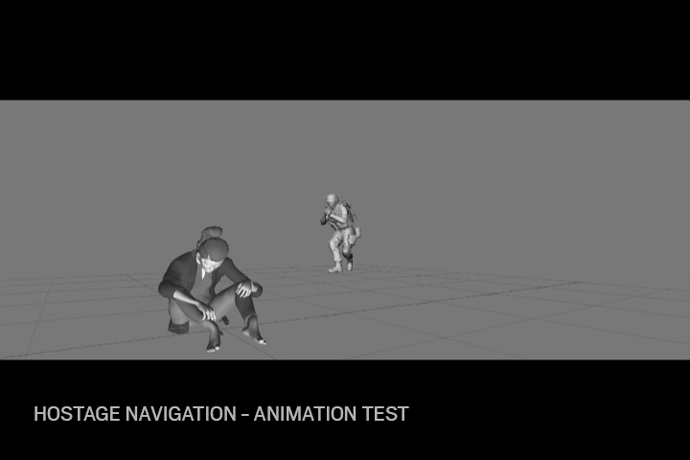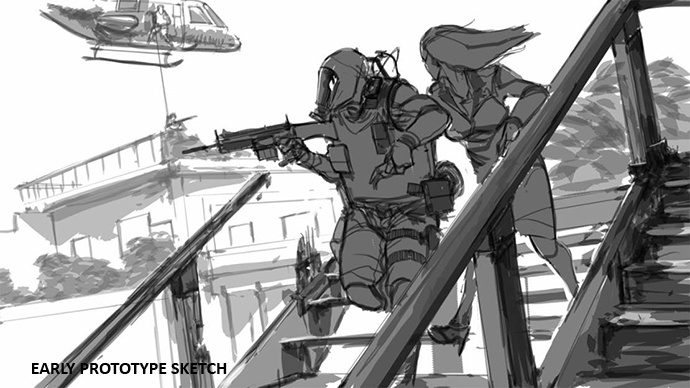Meaningful Objective-Driven Gameplay for Rainbow Six Siege
[“Behind the Wall” is a regular content series that explores various aspects of Rainbow Six Siege, based on the first demo shown. All design and content presented in these articles is a work in progress, and subject to change between now and the final release of the game.]
In October of 1977, members of Germany’s GSG 9 counter-terrorism unit stormed a Boeing 737 aircraft where 86 passengers and 5 crew members were being held by militants associated with the Red Army Faction in a terrorist hijacking. After help from Somali soldiers to distract the hijackers in the plane by lighting fires on the tarmac, GSG 9 breached through the aircraft’s doors, yelling in German at the passengers “Heads down! Where are the swines?” With a clear line of sight, members of the German CTU were able to neutralize the hijackers and escort all passengers to safety. From Lufthansa Flight 181, to other famous CTU operations like Iranian Embassy Siege or the Moscow theater hostage crisis, the concept of the siege and asymmetrical attack and defense is a consistent component. But the other consistent component of these CTU operations, and the reason they were such terrifying and delicate situations, is the presence of hostages. They weren’t just fighting an enemy or to gain a strategic objective, they were fighting to save lives.
“If we ask ourselves which mission creates the best story to tell, it isn’t disarming a bomb, it isn’t breaking into a building and making an assault... It is to be able to extract, to save, a hostage.”
In trying to embrace the counter-terrorism reality in Rainbow Six Siege, we initially focused our efforts on a game mode called Hostage Rescue. One defending team of five is holed up in a fortified structure in possession of a hostage, while the attacking five have just a few minutes to either locate and extract the hostage, or remove the threat by eliminating the enemy team. Both teams must take great care during the engagement, as any reckless moves that result in the death of the hostage will cause an immediate loss for the team in violation. It’s precisely these kinds of engagements that counter-terrorist units were created for and for Siege it adds great value to the experience at a fantasy and gameplay level. Our creative director, Xavier Marquis, explains:
“If we ask ourselves which mission creates the best story to tell, it isn’t disarming a bomb, it isn’t breaking into a building and making an assault... It is to be able to extract, to save, a hostage. We told ourselves that we were able to inject in the game, in the PVP, an immersive narrative with the inclusion of a hostage. We add a layer of reality for the player, letting them live the life of an intervention force.”
We actually had some GIGN members come visit the office to meet with us and play the game first-hand to verify that we were shaping the experience accurately. While a lot of people on our team are veteran FPS developers, at the end of the day we’re just gamers and consulting with the real operators helps make sure that we’re doing it right. We get to ask them a lot of questions and get great feedback. Interestingly enough, they told us that if given a choice to protect a teammate or a civilian, the GIGN operator would protect the civilian. That’s some serious dedication to preserving life and we wanted to emulate that kind of passionate commitment in the game.

Gary the hostage – he may not look like much, but he meant a lot to the team.
We put this to the test when we first tried out the Hostage Rescue game mode. Siege will have a variety of hostages from different backgrounds, and our first hostage was a muscular, completely green and utterly terrified man named Gary. We don’t implement fancy textures or any of the polish you see until much later on in development so yes, Gary looked as ridiculous as he sounds. Yet, he became the new focal point of each round and people seemed to actually care about him. As the matches would proceed, dev team members would rally for Gary’s sake, and speak about him after the rounds as if he were another player in the game. It persists even to this day. While searching for images of Gary to use in this blog post, game director Simon Larouche replied in an email thread, “Gary! We miss you!” The objective became central to the memories and stories created while playing a round, something that had never happened before.
The objective became central to the memories and stories created while playing a round, something that had never happened before.
Hostage Rescue not only fits well into the Rainbow Six fantasy, but the effect it has on gameplay as a result of that enhances the experience as well. The obvious impact of an objective is that it creates a hotspot on the map where action will tend to gravitate. By making that objective a hostage who can take damage and even be killed, it creates tension and demands a tactical approach. When killing the hostage is a lose condition, players become more careful as they get closer to the objective. Considering the high lethality of Rainbow Six Siege, it makes these close quarters encounters simultaneously delicate and explosive. As game designer Chris Lee puts it:
“You have to be careful when trying to breach into the area where the hostage is. You can’t just throw a frag or any explosives near the hostage without a second thought. You have to be very careful where you aim your weapon as well. It greatly increases the tension around the hostage, which differentiates it from other types of objectives.”
Once you’ve reached the hostage, a player on your team has to escort him/her. Moving with the hostage limits what the escorting player can do, making the operator more vulnerable. The movement rate is slowed down and only the pistol can be used. This is where communication and teamwork becomes paramount to completing the objective, as you’re more or less down a player while trying to extract the hostage. This stage in particular can be one of the most anxious parts of the whole round.

Animation test displaying the care and attention paid to the hostage while interacting.
When we hosted the first livestream gameplay session on Twitch, some of you had voiced concerns that rescuing the hostage wasn’t a viable win condition and that all of the rounds would end like a TDM (Team Death Match). Indeed, it’s the most common win scenario in Hostage Rescue, but extraction isn’t always the point. Even if the hostage isn’t extracted, it still has a big impact on player behavior. Lee tries to shed some light from a design standpoint:
“A round ending in TDM isn’t necessarily a bad thing. The hostage (or any objective) is there to provide areas of interest for firefights to happen. Players naturally gravitate towards the objective because of the incentive/threat. As soon as they close in on him or her, the tensions rise and everyone acts more carefully. The fact that the hostage isn’t being extracted all the time isn’t really an issue for us.”
That said, the inclusion of the hostage inspires creativity and it’s possible to win a round with other strategies. We’ve seen attacking teams try to distract the defenders, while one of their players would try to sneak in and get away with the hostage unnoticed. On the defenders’ side, we had teams attempt to stall the attackers and simply let the time run out, without taking a shot. It doesn’t happen often, but when a team pulls it off, it’s one of those rounds that you’ll be reminiscing with your teammates about for weeks after.

Successfully extracting a hostage during an operation is a great feeling.
All of this comes with its fair share of challenges. Having a hostage as the objective, alongside the no respawn rule, has traditionally been very difficult to implement in a PVP setting. In order for it to work, we will need to greatly incentivize it for the attackers and increase the threat for the defenders. We are working on making hostage escort and extraction easier, and we are planning on improving our interaction system. It will be tweaked to be quicker and to offer more extraction opportunities. The defending team not seeing the hostage as a threat, and thus roaming free around the map, is an issue but hopefully with these improvements that will change over the course of development. Lee elaborates on why it’s important that we design around this singular objective:
Like the real life operators from CTUs around the world, whose missions and actions inspired this franchise to be what it is, we want to put you in the position of actually caring about what you’re trying to accomplish and working with your team for something bigger than any individual.
“Usually, other games go around the issue by having two objective locations separated out. In Siege however, we want to create a strong fortified area as a point of interest. When you have multiple objectives, the siege isn’t as strong since the defenders are forced to go all in in one location or spread out too thin.”
Of course, we may introduce new game modes in the future with multiple objective locations that fits easier with the no respawn rule in effect, but we are ready to take on the challenge with Hostage Rescue to capture the essence of the Siege and provide you with a realistic and intense Rainbow Six experience. Like the real life operators from CTUs around the world, whose missions and actions inspired this franchise to be what it is, we want to put you in the position of actually caring about what you’re trying to accomplish and working with your team for something bigger than any individual.
- What other types of objectives would you like to see as Rainbow Six Siege game modes?
- Would you take a bullet for Gary?
[](https://www.reddit.com/r/rainbow6)

Chase “Electr1cPanda” Straight - Community Developer, Ubisoft Montreal
Chase is a goofy American ex-pat living in Canada who loves music, DJing, blogging, and obviously gaming for hours. No discrimination here, Chase loves consoles as much as playing on his homebuilt gaming rig. Say hi and send cat pics (bonus points if they're wearing R6 gear) on Twitter at @R6ComDevs.

Genevieve "Livinpink" Forget - Community Developer, Ubisoft Montreal
Gen goes by the handle Livinpink in the gaming industry. She is known for her involvement in multiple competitive gaming communities through her work as eSports media and personality. She participates in weekly livestreamed Dungeons and Dragons sessions. She also tweets from @R6ComDevs.



